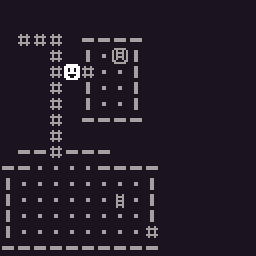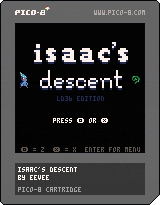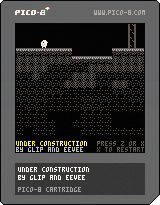Mel, Jayson, and I are attempting to construct a game called Flora. It seems obvious now that we’ve actually started: between us we have the pixels, the words, and the binaries. That’s everything right there.
I could blather about my adventures figuring out how to make OpenGL do anything useful, but who the hell cares. Far more interesting is the adventure of figuring out what the game actually is.
We have a pretty simple approach here: we’ve each played some decent set of video games, and we each have unreasonably strong opinions about what was good or bad. All we have to do is make a game with all the good stuff and none of the bad stuff. Done. Ship it.
The game revolves around Mel’s fictional universe, populated by all manner of colorful critters. The protagonists and namesakes are flowercats, so named because they are flowers with cats growing out of their stems.
It’s a top-down role-playing adventure, except everyone has a different idea of what that means, so let’s say it’s roughly the same style of game as Link’s Awakening. Turns out all three of us like adventuring: exploring a world, feeling like part of it, discovering secrets, finding teases of the plot, and hitting stuff. Luckily, the main characters are into the same kinds of stuff, so we’re off to a good start there.
The theme is turning out to be “elements”: both of nature (earth, fire, etc.) and of gameplay itself. We keep finding ways that distinct focus on each of exploration, puzzles, and combat seems appropriate. Possibly because each of us has a different favorite of the three.
Which brings me to the tricky bit: finding a middle ground between what we like and what drives us fucking bonkers.
- Good: Exploring a wide, open world. Bad: Calling GTA4 a “wide, open world”. Backtracking like crazy. Fast-travel that makes you never see the world. A map that, paradoxically, doesn’t show you where anything is or how to get to it.
- Good: Unlocking new ways to move through the environment. Bad: Realizing you don’t remember the ten places you saw an obstacle that you can now pass.
- Good: Collecting stuff. Bad: Being forced to collect the same worthless plot items to progress. Collection that doesn’t actually lead anywhere. Collection you don’t have a prayer of finishing until you’ve otherwised finished the game, thus turning it into a lame “post-game”.
- Good: A populated world. Bad: NPCs who walk back and forth their entire lives and only say one thing to you. A quantum world that seems to pause while you’re not around to look at it.
- Good: Multiple ways to defeat obstacles. Bad: Letting the player skip an obstacle with no punishment. Fallout 3.
- Good: A sense of progression. Bad: Screenfuls of stats that don’t seem to mean anything or change predictably. Huge numbers of stat-changing options. Minmaxing.
- Good: Novel puzzles that instill a sense of accomplishment when solved. Bad: Puzzles the game solves for you. Puzzles that are afraid to be difficult. Puzzles that rely on the author’s perspective. Puzzles that you can opt to skip, thus making solving it a complete waste of time.
Avoiding the bad is going to be tricky, to say the least. Some of these plague virtually every game because it’s just damn hard to do anything else. Still, I have every confidence that we are uniquely suited to avoid pitfalls that the biggest and most successful game development studios have yet to subvert. Cause we’re awesome.
So far we have one sprite drawn, and I’ve built an engine that lets it walk around a fixed region. (Spot the programmer art.) Basically done! I guess I’m building it half-from-scratch: I’m using pyglet and cocos2d, which provide a lot of basic niceties like event handling and layering and transformation and actions over time, but they’re both simple enough that I can easily understand everything they’re doing and could replicate it with a gun to my head. It’s the same kind of sweet spot as Pyramid is for Web development.
We have a Large Pad with tons of small ideas scribbled on it, and we brainstorm every other day. Currently trying to pin down how combat and advancement will work; there are a ton of options and getting it right is tricky. As the engine becomes useful, we’ll be able to actually try stuff out.
This is a side project among side projects for all of us, completely unfunded, with no deadline. So there’s no ETA, and we’ll just work on it as we feel inspired to do so. Interest is always interesting, of course.
The code is ISC and the assets are CC BY-NC-SA. All of it lives on GitHub. We’d still like to sell the completed game, but the plan is to only charge for the installer. (Oh, right: I develop on Linux (who doesn’t!) and it’s all Python and OpenGL, so it oughta run on pretty much anything.)
Yep, that’s all I got. May write about bits of it in more detail later, if there be interest.


![[updates]](https://eev.ee/theme/images/category-updates.png) Roguelike Simulator
Roguelike Simulator

![[personal]](https://eev.ee/theme/images/category-personal.png) Utopia
Utopia
![[articles]](https://eev.ee/theme/images/category-articles.png) Accessible games
Accessible games


![[process]](https://eev.ee/theme/images/category-process.png) Learning to draw, learning to learn
Learning to draw, learning to learn
![[dev]](https://eev.ee/theme/images/category-dev.png) Did some Spline work, again
Did some Spline work, again